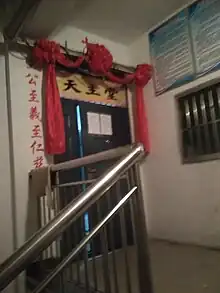| Tianzhu | |||||||||||||||||||||
|---|---|---|---|---|---|---|---|---|---|---|---|---|---|---|---|---|---|---|---|---|---|
 Catholic church in Tai'an, with sign reading 天主堂 (tiānzhǔ táng, "Hall of the Lord of Heaven") | |||||||||||||||||||||
| Chinese | 天主 | ||||||||||||||||||||
| Literal meaning | Heaven Master | ||||||||||||||||||||
| |||||||||||||||||||||
Tianzhu (Chinese: 天主; Wade–Giles: Tʻien-chu), meaning "Heavenly Master" or "Lord of Heaven", was the Chinese word used by the Jesuit China missions to designate God.[1]
History
The word first appeared in Michele Ruggieri's Chinese translation of the Decalogo, or Ten Commandments.[1] In 1584, Ruggieri and Matteo Ricci published their first catechism, Tiānzhǔ shílù (天主實錄, The Veritable Record of the Lord of Heaven).[2]
Matteo Ricci later wrote a catechism entitled Tiānzhŭ Shíyì (天主實義, The True Meaning of the Lord of Heaven).[1][2]
Following the Chinese rites controversy, the term Tiānzhŭ was officially adopted by the Pope in 1715, who rejected alternative terms such as Tiān (天, "Heaven") and Shàngdì (上帝, "Supreme Emperor").[3]
"Catholicism" is most commonly rendered as Tiānzhǔjiào (天主教, "Religion of the Lord of Heaven"). An individual Catholic is Tiānzhŭjiào tú;[4] tú includes the meanings "disciple" and "believer."[5] The same hanja characters are used in the Korean words for Catholicism and Catholic believer.
See also
References
- 1 2 3 Manufacturing Confucianism: Chinese traditions & universal civilization by Lionel M. Jensen p.73
- 1 2 The Jesuits: cultures, sciences, and the arts, 1540-1773, Volume 1 by John W. O'Malley p.365
- ↑ Chinese Christians in America: conversion, assimilation, and adhesive identities by Fenggang Yang p.52
- ↑ "Catholic", in Collins Chinese Concise Dictionary (2006), New York: HarperCollins.
- ↑ "tú" in Collins Chinese Concise Dictionary (2006), New York: HarperCollins.
Further reading
- Vincent Cronin (1955), The Wise Man from the West: Matteo Ricci and His Mission to China, New York: Dutton.
- 天主 (中國)